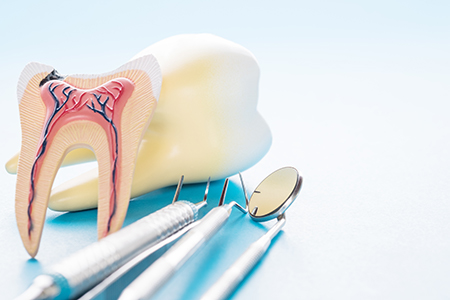
If a dentist tells you a tooth needs a root canal, it’s not a reason to panic. Advances in techniques and anesthesia have made root canal therapy a predictable, comfortable treatment that relieves pain and preserves teeth that would otherwise be lost. For many people, a root canal is less invasive than extraction and replacement and is often the best way to keep your natural bite and smile intact.
At the office of Newpoint Family Dental, we combine modern equipment with careful, patient-centered care to make root canal treatment as smooth as possible. We take time to explain why a procedure is recommended, how it will be performed, and what to expect during recovery so you can make informed decisions about your oral health.
Keeping your own tooth whenever it is feasible has real advantages. A preserved tooth maintains the alignment of neighboring teeth, supports the surrounding bone, and helps you chew and speak naturally. When a tooth is extracted, neighboring teeth can shift, bite forces change, and long-term restorative work may become necessary to restore function.
Root canal therapy removes the diseased tissues inside a tooth and seals the internal spaces to prevent reinfection. With proper restoration—most commonly a crown—the treated tooth can remain functional for many years, often for the remainder of your life. This is why clinicians frequently recommend treatment that preserves the tooth rather than immediate extraction.
Success rates for contemporary root canal procedures are high when treatments are performed with attention to technique and follow-up care. That favorable track record is the reason endodontic therapy remains a standard option for irreversibly damaged or infected teeth.

Not every toothache requires root canal therapy, but there are clear signs that something more serious is occurring inside a tooth. Increased sensitivity to temperature that lingers after the stimulus is removed, pain when biting, or a new, persistent ache are signals that the dental pulp may be inflamed or infected.
Other red flags include noticeable darkening of a tooth following trauma, swelling near the gumline, or a small bump on the gum that may drain fluid. Sometimes a problematic tooth causes no symptoms and is discovered on routine X-rays as an area of bone loss at the root tip.
When we evaluate a suspect tooth, our examination includes a careful clinical assessment, diagnostic X-rays, and discussion of your symptoms. This approach helps determine whether root canal therapy is the appropriate step or if other treatment paths are better suited to your situation.
Pain that persists or intensifies—especially pain that awakens you at night or lasts after hot or cold exposure—often indicates deep decay or nerve irritation that may require root canal treatment.
If hot or cold foods produce a sharp sensation that continues after the food is gone, the nerve tissue inside the tooth may be compromised and should be evaluated promptly.
Discomfort while chewing or pain on light touch suggests the inflammation has reached the inner structures of the tooth or that an infection is present.
Tooth discoloration after an injury or over time can reflect internal changes to the pulp. This change often signals that the tooth’s internal tissues are no longer healthy.
Structural damage from trauma or wear can expose or injure the pulp. In many cases, treating the internal tissues preserves the remaining tooth and prevents further complications.
Swollen gums, an abscess, or drainage near a tooth are indicators of infection that often require timely root canal therapy to control the process and protect surrounding tissues.
Advanced infection can affect the bone that supports a tooth and lead to mobility. Treating the source of infection can allow healing and help stabilize the tooth.

Time plays an important role when a tooth’s internal tissues are compromised. Early diagnosis and intervention can prevent a local problem from becoming more extensive. Left untreated, an infected tooth can lead to larger areas of bone loss and a greater risk of spreading infection.
Some teeth that need treatment are discovered before symptoms appear during routine exams or X-rays. When that happens, addressing the issue early often simplifies treatment and improves long-term outcomes. A delayed approach can result in more complex procedures or the need for extraction.
Our practice emphasizes careful diagnostics and timely care planning so patients understand options and next steps. When root canal therapy is recommended, the goal is to restore health to the tooth and minimize future complications through well-timed treatment and appropriate restoration.
Root canal therapy removes the inflamed or infected pulp from within the tooth, cleans and shapes the internal canals, and seals them with a biocompatible material. Modern instruments, magnification, and local anesthesia allow this work to be performed precisely and comfortably.
Some cases are completed in a single appointment; others need more than one visit, particularly if an active infection requires interim medication or the tooth has complex anatomy. Treatment length is determined by the number of canals, the tooth’s condition, and the presence of infection.
After the root canal is finished, the tooth is restored to protect it from fracture and reinfection—most commonly with a crown or a well-designed filling. A full restoration restores function and distributes chewing forces to help the tooth perform normally for years to come.

Following a root canal, mild to moderate soreness for a few days is common as surrounding tissues heal. Over-the-counter pain relievers are usually effective; if stronger medication is needed, we will prescribe it. Keeping the treated tooth out of heavy biting while it is being restored helps reduce discomfort and protects the tooth.
If antibiotics are prescribed for an active infection, it is important to finish the full course. Good oral hygiene and routine dental visits support healing and help detect any concerns early. A treated tooth should be restored with a permanent crown or restoration in a timely manner to prevent fracture and ensure longevity.
With careful maintenance—regular brushing, flossing, and dental checkups—a tooth that has undergone root canal therapy often functions well for many years. If you experience new or worsening symptoms after treatment, contact our office so we can assess the situation and provide prompt care.
We’re committed to helping patients preserve healthy, comfortable smiles. If you have questions about root canal therapy or think you may need evaluation, contact Newpoint Family Dental for more information and to discuss the next steps.
Root canal therapy is a dental procedure that removes inflamed or infected pulp from inside a tooth, cleans and shapes the internal canals, and seals them with a biocompatible material. The primary goal is to eliminate infection, relieve pain, and preserve the natural tooth structure. Modern root canal treatment uses local anesthesia, magnification, and precise instruments to complete these steps safely and predictably.
After the canals are sealed, the tooth typically requires a final restoration such as a crown or a well-designed filling to protect it from fracture and reinfection. With proper restoration and maintenance, a treated tooth can function normally for many years. Early diagnosis and timely treatment help simplify the procedure and improve long-term outcomes.
Common signs that suggest a tooth may need root canal therapy include persistent or worsening toothache, sensitivity to hot or cold that lingers after the stimulus is removed, pain when biting, and swelling or a small bump on the gum near the affected tooth. A tooth that darkens after trauma or shows evidence of bone loss at the root tip on X-rays can also indicate pulp damage. Not all problematic teeth cause symptoms, which is why routine exams and radiographs are important for detection.
When we evaluate a suspect tooth, our assessment includes a clinical exam, diagnostic X-rays, and a review of your symptoms to determine whether root canal treatment is appropriate. At Newpoint Family Dental, we explain findings and treatment options so patients can make informed decisions. Timely evaluation often prevents more extensive problems and preserves long-term function.
The procedure begins with local anesthesia to numb the tooth and surrounding tissues so you remain comfortable. The dentist creates an access opening, removes the diseased pulp, cleans and shapes the internal canal system, and then fills and seals the canals with a biocompatible material to prevent reinfection. Modern care often includes magnification, digital X-rays, and precise instruments to address complex anatomy.
Some cases are completed in a single visit, while others require multiple appointments if there is an active infection or complicated canal structure that benefits from interim medication. After the root canal is finished, the tooth receives a permanent restoration to restore strength and function. Follow-up visits confirm healing and the success of the treatment.
Most patients report that the procedure itself is no more uncomfortable than having a routine filling because effective local anesthesia prevents pain during treatment. After the appointment, mild to moderate soreness for a few days is common as surrounding tissues heal, and this is usually managed with over-the-counter pain relievers. If more significant pain or inflammation is present before treatment, eliminating the infection often brings substantial relief.
Your clinician will provide instructions for managing discomfort and, when necessary, prescribe medication to control pain or treat an active infection. Keeping the treated tooth out of heavy biting until it is fully restored can reduce postoperative sensitivity. If you experience severe or worsening pain after treatment, contact the office promptly for evaluation.
Recovery from the procedure is generally short; most people resume normal activities the same day and report only minor soreness for a few days as tissues heal. Over-the-counter analgesics typically control discomfort, and if antibiotics are prescribed for a spreading infection it is important to complete the full course. Avoiding hard or chewy foods on the treated tooth until it is restored helps prevent fracture and reduces sensitivity.
If a temporary filling was placed, you will return for a permanent restoration, often a crown, to protect the tooth long term and restore normal chewing function. Follow-up appointments allow your dentist to monitor healing and confirm that the tooth is stable. If symptoms persist or new pain arises, prompt reassessment helps address any complications early.
Contemporary root canal therapy has high success rates when performed with careful technique and followed by appropriate restoration. Many treated teeth remain functional for decades with good oral hygiene and routine dental care, and some last a lifetime. The long-term prognosis depends on factors such as the tooth's structural integrity, the presence of preexisting infection, and the quality of the final restoration.
Occasionally a treated tooth may require retreatment or a surgical procedure if symptoms recur or persistent infection is detected on X-rays. Regular dental checkups and prompt attention to changes in comfort or function help identify concerns early and preserve the tooth. Good home care, including brushing, flossing, and addressing habits like grinding, supports the longevity of treated teeth.
The main alternative to root canal therapy is extraction of the affected tooth, which may then be followed by options to replace the missing tooth such as a bridge, implant, or removable prosthesis. Extraction removes the source of infection but also leads to changes in bite, potential shifting of neighboring teeth, and loss of supporting bone over time. For many patients, preserving the natural tooth with root canal treatment is preferable when feasible.
In select situations a period of observation or conservative treatment may be appropriate, but delaying definitive care can allow infection to spread and complicate future treatment. Your dentist will review all reasonable options, explain the expected outcomes of each choice, and recommend the approach that best preserves oral health and function.
A root canal can often treat a cracked or traumatized tooth when the pulp is inflamed or infected, but the success depends on the extent and location of the crack or injury. If the crack reaches the pulp or allows bacteria to enter the root system, root canal therapy followed by a protective restoration such as a crown is commonly recommended to preserve the tooth. When cracks extend below the gum line or involve significant structural breakdown, extraction may be the only viable option.
Prompt evaluation after trauma increases the chance of saving the tooth and limits complications. Your dentist will assess the tooth clinically and with radiographs to determine whether the pulp is compromised and to plan appropriate treatment. Timely stabilization and restoration help restore function and reduce the risk of further damage.
Preparation is generally straightforward: bring a list of current medications and medical conditions, arrive with any recent dental records if available, and plan for a normal meal beforehand unless otherwise instructed for sedation. Discuss any allergies, bleeding disorders, or concerns about anesthesia with your dentist so the care team can tailor pain control and medications safely. If you experience dental anxiety, let the office know ahead of time to review comfort measures or sedation options.
If you choose or require sedation, arrange for a responsible adult to drive you home after the appointment and follow any pre-appointment instructions provided by the practice. Otherwise you can usually resume routine activities after treatment, though you may want to avoid strenuous exercise for the remainder of the day. Clear communication with your dental team helps ensure a smooth, predictable visit.
Long-term success begins with timely placement of a permanent restoration, often a crown, to protect the treated tooth from fracture and reinfection. Daily oral hygiene with thorough brushing and flossing, along with regular dental checkups and cleanings, helps prevent new decay and supports the health of the treated tooth and surrounding tissues. If you grind or clench your teeth, a night guard can reduce destructive forces that increase the risk of fracture.
Monitor the treated tooth for changes such as new pain, swelling, or altered biting and contact your dentist promptly if concerns arise. Regular radiographic and clinical follow-up allows your clinician to detect potential issues early and recommend appropriate care. For personalized guidance or to schedule an evaluation, contact Newpoint Family Dental to discuss next steps and ongoing maintenance.
Our mission is to help every patient enjoy healthy teeth and a confident smile, providing care that meets your needs and exceeds expectations.
